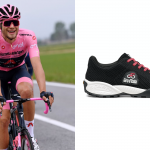
A chromatic guide to the Giro d'Italia 2019
Knowing the colors of the shirts are essential to understanding the tactics in the most important bicycle race in Italy
May 24th, 2019
The first week of the 102th edition of Giro d'Italia has already finished and in addition to the sporting show offered by cyclists surrounded by the landscape visions offered by the most beautiful country in the world (this year they start from Bologna and after more than 3500 km they arrive in Verona, on June 2nd), there is always glance given to the beautiful colors of the jerseys worn by the riders, 176 divided into 22 different teams.
The Rosa race has a color range that goes far beyond the color of its main jersey and has over the years assigned other "colors" to the winners of the other rankings parallel to the general classification: the blue, white, cyclamen and, for a while, the legendary black jersey. In addition to a historical meaning, recognizing the colors of the various formations is fundamental for understanding the running logic: this guide, besides explaining the origins and anecdotes related to the jerseys, will help you to identify and better understand how the professionals compete by following the precise group movements.

ROSA
The Pink is the main color of the race, but if you think it has always been this way you are wrong: the Giro was born in 1909 but only in 1931 was the Pink Jersey introduced. It was the journalist Armando Cougnet, the first organizer and creator of the race, who had the idea of setting up the leader's jersey to allow the public to identify him. Already at the Tour de France the leader wore the yellow jersey and, taking inspiration from there, it was decided to use the pink that was already the color of the pages of the Gazzetta dello Sport, which has always been the organizer of the race.
The shade of pink has never been the same over the years: the first was of rose-color and was worn by Learco Guerra who in 1931 won the Milan-Mantua stage, made of raw wool, with a high neck and weighed about 3 ounces.
Synthetic fibers appeared only in the seventies and for two years the Maglia Rosa has been produced by Castelli Cycling, a leading brand in cycling clothing that has also collaborated with Supreme. Becoming ever lighter and more technical, the latest innovation was presented this year with Intimissimi: the collaboration with the underwear brand is the first internal sponsor, present under the zip and visible only in a loose shirt in direct contact with the athlete, recalling the slogan "experience the emotion on your skin".
AZZURRO
"Blue like the torrent in flood, which flows from the source and reaches the bottom of the sea. Blue, but not firm, like the water of a lake among the glaciers". Thus, the organization describes the jersey of the first position in the mountain Grand Prix, first among those who climb the peaks of the Giro d'Italia. It is the oldest accessory classification of the Giro, having been established in 1933, but it is also the youngest of all. Since 1933, there have been a ranking of climbers, but only in 1967 was the jersey worn by the one who conquered the most points when he reached the top of the Giro d'Italia. The most difficult a mountain to climb the more points are assigned, while the simpler, sometimes hilly, slopes assign less.
If you look for images of past years, you have to be careful not to get confused: the shirt of the climber's classification was, in fact, green until 2012, when the title sponsor of the Banca Mediolanum ranking changed the color to blue.
The blue was present from 1989 to 2006 to indicate another ranking that is no longer present: to make the race animated from the first stages, the organization introduced a ranking based on travel times without counting the bonuses, that is the second ones that are taken away from those who win particular stages.
BIANCO
It is the only one that is also shared with the Tour de France: both on Italian and French roads, white is worn by the best of the general classification reserved for young people, those who have not yet reached the age of twenty-five in the year of the race.
As white is a color rarely used by the teams, it is very visible in a group and above all a very tight jersey: only on two occasions has the winner of the white jersey, in fact, won the general classification, a symbol of how for young riders this jersey is only really possible to wear at the end of the race.
Founded in 1976, it was not assigned from 1995 to 2006, when it was reintroduced replacing the Intergiro ranking and allowing even the youngest to wear a shirt, perhaps the most elegant of all.
CICLAMINO
It is the most historical jersey among the accessory classifications of the Giro d'Italia, yet it has not always been assigned. The points classification in the history of the Giro d'Italia even precedes the one in time, as in the first four editions the victory was assigned to those who scored more points passing under the stage goals. It was then introduced as stand-alone standing only in 1958 and resumed in 1967, the year in which the rider at the top of this ranking began to wear a dedicated jersey.
Until 1970 it was red because, as often happens in cycling, it took on the color of its first sponsor, which at the time was Dreher, whose color is red. He became Ciclamino in 1970 when the title sponsor of the jersey became Termozeta and so remained until 2010, when the jersey returned back to "Rosso Passione". Onto the green jersey (so it was the jersey of the climbers' standings) and to the white one of the young standings, it was going to form the tricolor of the Italian flag giving a unique look. Over the years it became associated with various brands that adopted red as a color, such as Algida and Italo. Often won by sprinters, who won several points in sprint arrivals, it returned to cyclamen in 2017 thanks to the new title sponsor Segafredo Zanetti: a curious choice because, despite the brand's red logo within the 'S' it was decided to return to the cyclamen color recalling a historical tradition, as is the coffee produced by the company.
NERO
There are cyclists who, from the first stage, are waiting for nothing but to arrive in the mountains to be able to play the final victory, and others who stop step by step in the final part of the group. Often it is the younger ones or those who have to do the "dirty jobs" for the team, like going to the flagship to get water bottles and food supplies by shuttling between the car and their teammates.
From 1946 to 1951 it was decided to assign the black jersey, worn by the latter in the overall standings to celebrate and respect the effort made by everyone during the race.
Black was not chosen to indicate the "black sheep", but derives from a football team. This shirt was inspired by Giuseppe Ticozzelli, a footballer who in 1920 decided to participate in the Giro as an independent, wearing the Casale shirt, the team he was playing for, which was in fact black.
Disappearing from the Giro d'Italia just 5 years after its introduction because it soon became too popular: the cyclists were fighting to finish last and win, in addition to an economic prize, a real symbol loved by the fans. These are the only ones that still today consider the "virtual black jersey" while the organization, to remember this historical tradition, introduced only for the 2008 edition the "black number" brought on by the last in the standings.






























